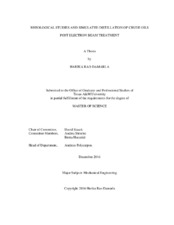| dc.description.abstract | Use of electron beam irradiation could effectively transfer energy to crude oil, resulting in improved cracking and reduction of operating temperatures. The overall objective is to crack heavy oil and make it less viscous while avoiding generation of micro-carbon residue and olefins. A flow loop system has been built to dynamically treat extra-heavy crude oils with electron beam. Operating temperature, dose rate, dose and shear rate have been identified to be the important parameters.
This thesis focuses on analyzing the fluid properties and characterization of heavy crude oils pre and post treatment. Extra-heavy crude oil and bitumen with API gravity in the range of 7-8⁰ (viscosity; order of 106cP at 40⁰C) have been used for this study. Rheological studies and viscosity measurements have been performed using a rheometer. Existing viscosity-temperature models have been modified and utilized to obtain continuous viscosity-temperature plots. Further, blending experiments have been conducted to understand the effect of addition or loss of different yields (lighter fractions, middle distillates, heavy residue etc.) and account for discrepancies in mass balance.
Oil characterization has been carried out using simulated distillation on a gas chromatograph. High temperature simulated distillation methods such as ASTM D6352 and ASTM D7169 have been used for the same. Polywax 655 has been employed to obtain the retention time calibration. Percentage weight off versus boiling point (% wt off vs BP) has been measured to obtain the % conversion post treatment.
Experimental process conditions were broadly tested. Temperatures in the range of 100-300⁰C, dose rates of the order of 15-25 kGy/s and absorbed dose in the range of 20-1700 kGy were employed during the experiments. Initial tests yielded a reduction in viscosity of 50% for oil #1 (1300 kGy, 20 kGy/s) and 39% for oil #2 (560 kGy, 20 kGy/s) measured at 100⁰C. Simulated distillation results indicate a sample conversion of 9.84% and residue conversion (above 1000⁰F) of 20.95% for oil #2 at conditions stated above. For oil #1, sample conversion was 6% and residue conversion (above 1000⁰F) was 16.8% at conditions stated above. | en |


